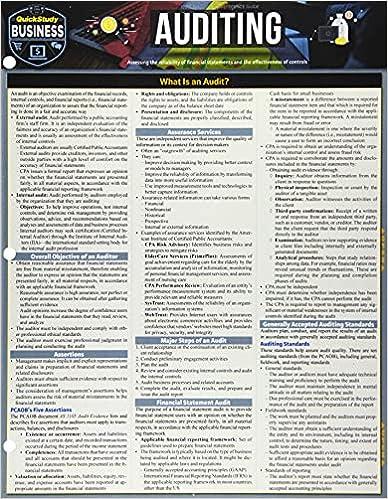Question
1.Which of the following general ledger accounts is a temporary account? a Prepaid Expense b Supplies c Supplies Expense d Accumulated Depreciation 2.A debit entry
1.Which of the following general ledger accounts is a temporary account?
a Prepaid Expense b Supplies c Supplies Expense d Accumulated Depreciation
2.A debit entry would cause a decrease in which of the following accounts?
a Treasury stock b Additional paid-in-capital - common stock c Sales expense d Accounts receivable
3 A debit entry would cause an increase in which of the following accounts?
a Accounts payable b Depreciation expense c Sales revenue d Common stock
4. Which of the following is the best description of "retained earnings"?
a the residual interest when liabilities are deducted from assets b earned equity minus what is distributed to owners c investments by owners d probable future sacrifices of economic benefits arising from present obligations
Classify the accounts below using these codes:
a Asset d Revenue or gain b Liability e Expense or loss c Equity or Contra-equity
5. _______Common stock
6._________Accounts receivable
7._______Treasury stock
8. A corporation issues 1,000 shares of common stock for $40,000. The stock has a par value of $10 per share. The journal entry to record the stock issuance would include a credit to Common Stock for
a $1,000 b $10,000 c $40,000 d $30,000
9. The outstanding stock of a corporation is composed of 500,000 shares of $10 par, cumulative preferred 8% stock, and 50,000 shares of $1 par common stock. Calculate the dollar amount of annual cash dividends that are to be paid to preferred shareholders.
a $50,000 b $450,000 c $400,000 d $80,000
10.A corporation reacquires 1,000 shares of its own $25 par common stock for $45,000, recording it at cost. What effect does this transaction have on stockholders' equity?
a It increases stockholders' equity by $45,000. b It has no effect on stockholders' equity. c It reduces stockholders' equity by $25,000. d It reduces stockholders' equity by $45,000.
11. The net effect to a corporation of the declaration and payment of a cash dividend is to
a increase stockholders' equity and decrease liabilities b decrease liabilities and decrease stockholders' equity c increase assets and increase stockholders' equity d decrease assets and decrease stockholders' equity
12. A corporation has 40,000 shares of $25 par value stock outstanding. If the corporation issues a 4-for-1 stock split, the number of shares outstanding after the split will be
a
120,000 shares b 40,000 shares c 160,000 shares d 10,000 shares
XYZ Company acquired from shareholders 1000 shares of treasury stock for $25 per share. XYZ reissued the same 1000 shares of treasury stock for $28 per share. Par value of the stock is $10 per share.
13.The journal entry to record the acquistion of the treasury stock would include the following:
a a debit to Cash of $28,000 b a debit to Cash of $25,000 c a credit to Treasury Stock of $25,000 d a debit to Treasury Stock of $10,000 e a credit to Cash of $25,000
14.The journal entry to record the reissuance of the 1000 shares of treasury stock would include the following:
a a debit to Cash of $28,000 b a debit to Cash of $25,000 c a credit to Treasury Stock of $28,000 d a debit to Treasury Stock of $28,000 e a credit to Paid-In Capital from Sale of Treasury Stock of $28,000
15.A corporation has 250,000 shares of ($60 par) common stock authorized and 100,000 shares of common stock issued at par. Seventeen-thousand, five-hundred (17,500) shares of common (stock have been reacquired for $65 per share and placed in the treasury. What amounts should be reported in the Common Stock and Treasury Stock accounts?
a Common Stock $6,000,000 credit and Treasury Stock $1,137,500 debit b Common Stock $15,000,000 credit and Treasury Stock $1,137,500 debit c Common Stock $15,000,000 credit and Treasury Stock $1,050,000 debit d Common Stock $6,000,000 debit and Treasury Stock $1,137,500 credit
16. Bonds that are unsecured but are backed by the general credit of the issuing corporation are called:
a assurance bonds b coupon bonds c bearer bonds d debenture bonds
17. A bond indenture may require the bond issuer to set aside amounts to pay the bond's face amount at maturity. The amounts are place in a separate asset account called a
a superfund b sinking fund c indenture fund d debenture fund
18. A corporation may issue callable bonds to protect itself against significant
a increases in future interest rates b changes in the federal funds rate c decreases in future interest rates d changes in present value tables
19. A corporation issued $1,000,000 of 11%, five-year bonds that pay semiannual interest of $55,000, receiving cash of $1,038,606. At issuance, the corporation should record:
a a debit to Bonds Payable of $1,038,606. b a credit to Bonds Payable of $1,038,606. c a credit to Bonds Payable of $1,000,000. d a credit to Cash of $1,000,000.
Step by Step Solution
There are 3 Steps involved in it
Step: 1

Get Instant Access to Expert-Tailored Solutions
See step-by-step solutions with expert insights and AI powered tools for academic success
Step: 2

Step: 3

Ace Your Homework with AI
Get the answers you need in no time with our AI-driven, step-by-step assistance
Get Started


